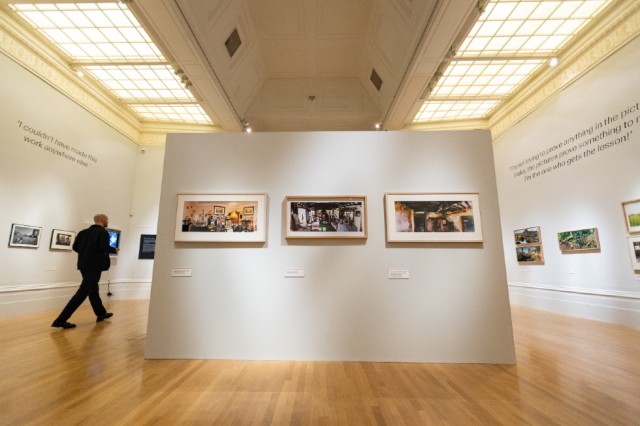Social Issues and Artful Output – Photie Man: 50 Years of Tom Wood

“Perhaps the most remarkable thing about Wood’s pictures is the humanity so near to their surface.” Mike Pinnington on Photie Man: 50 Years of Tom Wood…
Photography is full of dualities. Not least presence and absence. A person, a moment, a feeling – all can be frozen for all time in a click, the instant that it takes to capture them. Infinity and a moment all at once. To look at photographs (of ourselves, friends, loved ones or strangers), therefore, is to experience existential reflection; at the events of lives lived up until the image is made. They also provoke sliding doors moments. So we have contemplation of the roads taken, of stories written – and otherwise.
There are many moments of and opportunities for such reflection in Photie Man: 50 Years of Tom Wood, an exhibition currently on display at Walker Art Gallery. In a vitrine of vintage photographs collected and organised by the photographer when he was just a boy, the lives of others leap out at us from the miasma of a murky past. When Wood was rooting for these photos – of weddings, family occasions, soldiers, and days at the beach – in charity shops, he was after discarded old snaps that had what he calls ‘a real presence’.
Undeniably they have that. We see pictures of families; are the youngest sitters still alive? Who were they? What did they do? Were they happy? We can’t know, but it doesn’t stop us wondering, filling in gaps, even hoping that they had full and happy lives. Reflected in these people you can see many of the concerns that have fascinated and sustained Wood’s long career to this moment in time – not least the humanity and potential riches he sees, via the lens of his camera, in everyday lives lived by everyday people like you and me.
The curiosity that led to his impulse to collect and categorise the images by type in his youth became a vocation in adulthood. But his route was a circuitous one. Born in 1951 in County Mayo, come the 70s he was studying painting at Leicester polytechnic, and first picked up a camera in earnest to document his work. Soon, though, the camera and photography, rather than paint, became the thing. Coming to this conclusion, his intention, he has said, “was to make interesting pictures…”
This impulse is writ large on the gallery wall at the Walker, and it is repeated more than once in the accompanying exhibition texts, almost as if the curators were concerned we wouldn’t be able to see this for ourselves. They needn’t have worried: this substantial survey is jam packed with interesting pictures – a modest phrase which hardly does them justice.
Among the first images that you encounter, shot in black and white (though he would soon shift to colour) is Self portrait (in photobooth mirror), early 1970s. Avoiding commonplace pitfalls of what today we might think of as a kind of selfie, it demonstrates a certain playful intelligence; an artfulness beyond the norm and an enquiry into what could be achieved with a camera. A hint of things to come.
We follow Wood through the exhibition by decade; he moves, in 1978, to Liverpool. It was here that the majority of the photographs on display were made, and where he earned the nickname ‘photie man’. He says that in Liverpool, Wirral and wider Merseyside, he’d “fed off the energy there”, confessing that he “couldn’t have made this work anywhere else.”

Set against the backdrop of Thatcher, strikes, and a city in strife, Wood captured it all and, I’m sure, saw more. The period and place produced some of his best- and best-known work. Indeed, you probably recognise more of Wood’s work than you think. Even if you’re relatively familiar with him. Arriving at the section containing his Pier Head pictures, is like bumping into old friends.
In so fraught a decade, perhaps the most remarkable thing about Wood’s pictures, is the humanity so near to their surface, a quality that his contemporaries – often working with ostensibly the same themes in similar communities, landscapes and geographies – sometimes overlook. This might be demonstrated in a one-off picture capturing the look of love from one partner to another in the park, or in a deliberate, poignant series, such as Care in the Community, begun in 1988. The project took Wood to Rainhill Hospital psychiatric facility, where a proposed six weeks turned into two years as the hospital prepared for closure.

Wood’s photographs never exist simply for documentation, though. Indeed, another quote on the wall states: “You’re asking a question when you take a picture, you’re not trying to document something.” He sets out to make interesting pictures and he does. He regularly comfortably surpasses this objective.
 Some of my favourites in the exhibition occupy simultaneously the worlds of photography and art. In All Zones Off Peak – a project spanning twenty years spent on and around public transport – we find people, the elements, reflections of bus- and bus-stop windows. Possessing a sublime quality, they veer into the abstract.
Some of my favourites in the exhibition occupy simultaneously the worlds of photography and art. In All Zones Off Peak – a project spanning twenty years spent on and around public transport – we find people, the elements, reflections of bus- and bus-stop windows. Possessing a sublime quality, they veer into the abstract.
In Birkenhead’s Cammell Laird Shipyard, machinery, rust, handfuls of remaining workers and desolate 1990s workspaces speak of post-industrial ghosts, painting a picture of threatened job losses and intense uncertainty. Here, it’s as if Wood is collaging with light, such are the layers he captures and presents fully formed.
Such works, like his wider practice, are a fruitful collision of social issues led work and sensitive, artful output. His fifty years’ worth of photographs present us with yet another duality to add into the mix, one in which visual poetry and quotidian scenes exist and hold space in equal measure.
Mike Pinnington
Photie Man: 50 Years of Tom Wood continues at Walker Art Gallery until 7 January 2024
Further Reading: Profile: “Tom Wood’s photographs are about photography”
Images: PhotieMan installation photography © Robin Clewley; Couple with new baby, Sefton Park 1980; Mirror Mersey, 1989; Cutting, 1995, all © Tom Wood





